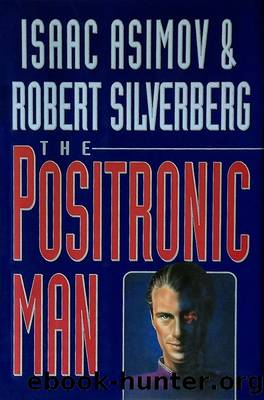The Positronic Man (with Robert Silverberg) by Isaac Asimov

Author:Isaac Asimov [Asimov, Isaac]
Language: eng
Format: epub
Tags: Science
ISBN: 9780385263429
Publisher: Doubleday; Bantam Doubleday Dell
Published: 1992-01-01T16:00:00+00:00
THIRTEEN
ANDREW EXPERIENCED a sensation of discomfort after Little Missâs death that would not leave him for weeks. To call it grief might be a little too strong, he thought, for he suspected that there was no place in his positronic pathways for any feeling that corresponded exactly to the human emotion known as grief.
And yet there was no question but that he was disturbed in some way that could only be traced to the loss of Little Miss. He could not have quantified it. A certain heaviness about his thoughts, a certain odd sluggishness about his movements, a perception of general imbalance in his rhythmsâhe felt these things, but he suspected that no instruments would be able to detect any measurable change in his capacities.
To ease this sensation of what he would not let himself call grief he plunged deep into his research on robot history, and his manuscript began to grow from day to day.
A brief prologue sufficed to deal with the concept of the robot in history and literatureâthe metal men of the ancient Greek myths, the automata imagined by clever storytellers like E. T. A. Hoffmann and Karel Äapek, and other such fantasies. He summarized the old fables quickly and dispensed with them. It was the positronic robotâthe real robot, the authentic itemâthat Andrew was primarily concerned with.
And so Andrew moved swiftly to the year 1982 and the incorporation of United States Robots and Mechanical Men by its visionary founder, Lawrence Robertson. He felt almost as though he were reliving the story himself, as he told of the early years of struggle in drafty converted-warehouse rooms and the first dramatic breakthrough in the construction of the platinum-iridium positronic brain, after endless trial-and-error. The conception and development of the indispensable Three Laws; research director Alfred Lanningâs early triumphs at designing mobile robot units, clumsy and ponderous and incapable of speech, but versatile enough to be able to interpret human orders and select the best of a number of possible alternative responses. Followed by the first mobile speaking units at the turn of the Twenty-First Century.
And then Andrew turned to something much more troublesome for him to describe: the period of negative human reaction which followed, the hysteria and downright terror that the new robots engendered, the worldwide outburst of legislation prohibiting the use of robot labor on Earth. Because miniaturization of the positronic brain was still in the development stage then and the need for elaborate cooling systems was great, the early mobile speaking units had been giganticânearly twelve feet high, frightful lumbering monsters that had summoned up all of humanityâs fears of artificial beingsâof Frankensteinâs monster and the Golem and all the rest of that assortment of nightmares.
Andrewâs book devoted three entire chapters to that time of extreme robot-fear. They were enormously difficult chapters to write, for they dealt entirely with human irrationality, and that was a subject almost impossible for Andrew to comprehend.
He grappled with it as well as he could, striving to put himself in
Download
This site does not store any files on its server. We only index and link to content provided by other sites. Please contact the content providers to delete copyright contents if any and email us, we'll remove relevant links or contents immediately.
Sita - Warrior of Mithila (Book 2 of the Ram Chandra Series) by Amish(51424)
The Crystal Crypt by Dick Philip K(35683)
Cat's cradle by Kurt Vonnegut(13868)
Always and Forever, Lara Jean by Jenny Han(13638)
Ready Player One by Cline Ernest(12838)
The Last by Hanna Jameson(9221)
Year One by Nora Roberts(8474)
Persepolis Rising by James S. A. Corey(8269)
The remains of the day by Kazuo Ishiguro(7551)
Dark Space: The Second Trilogy (Books 4-6) (Dark Space Trilogies Book 2) by Jasper T. Scott(7370)
Red Rising by Pierce Brown(7326)
Never let me go by Kazuo Ishiguro(7128)
The handmaid's tale by Margaret Atwood(6852)
The Circle by Dave Eggers(6257)
Legacy by Ellery Kane(5946)
The Testaments by Margaret Atwood(5781)
Frank Herbert's Dune Saga Collection: Books 1 - 6 by Frank Herbert(5676)
Pandemic (The Extinction Files Book 1) by A.G. Riddle(5589)
Six Wakes by Mur Lafferty(5203)
